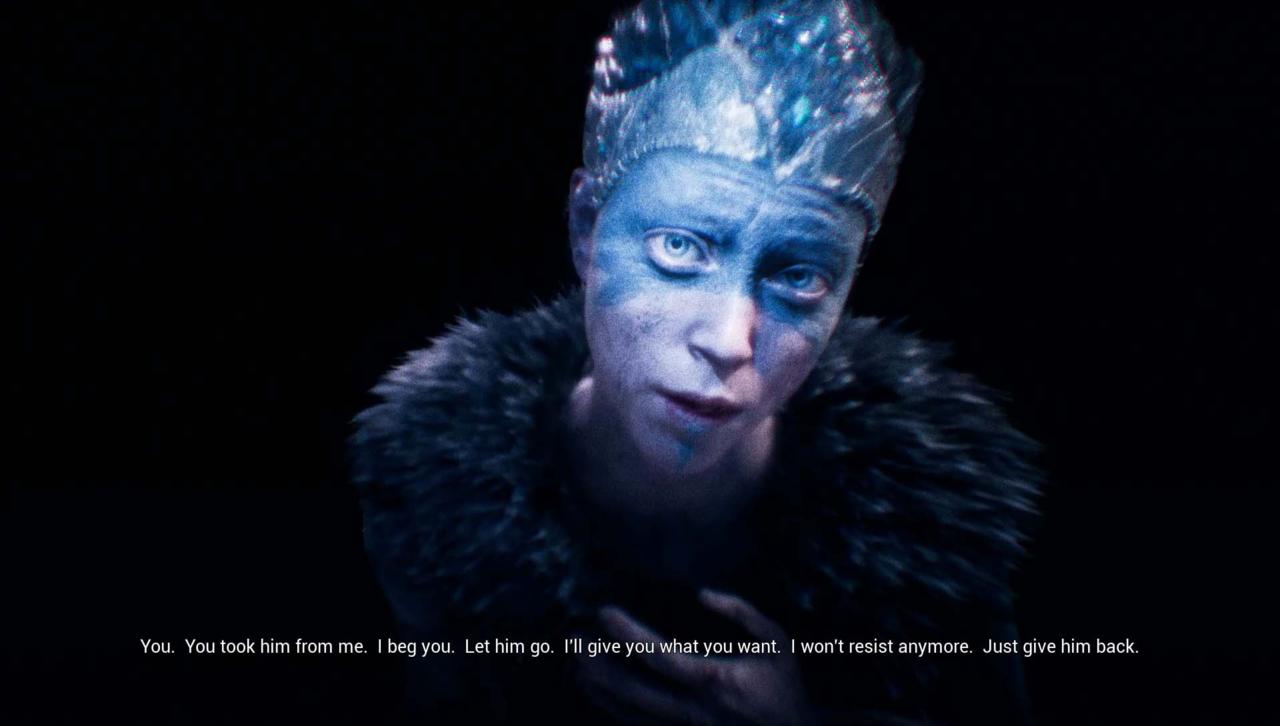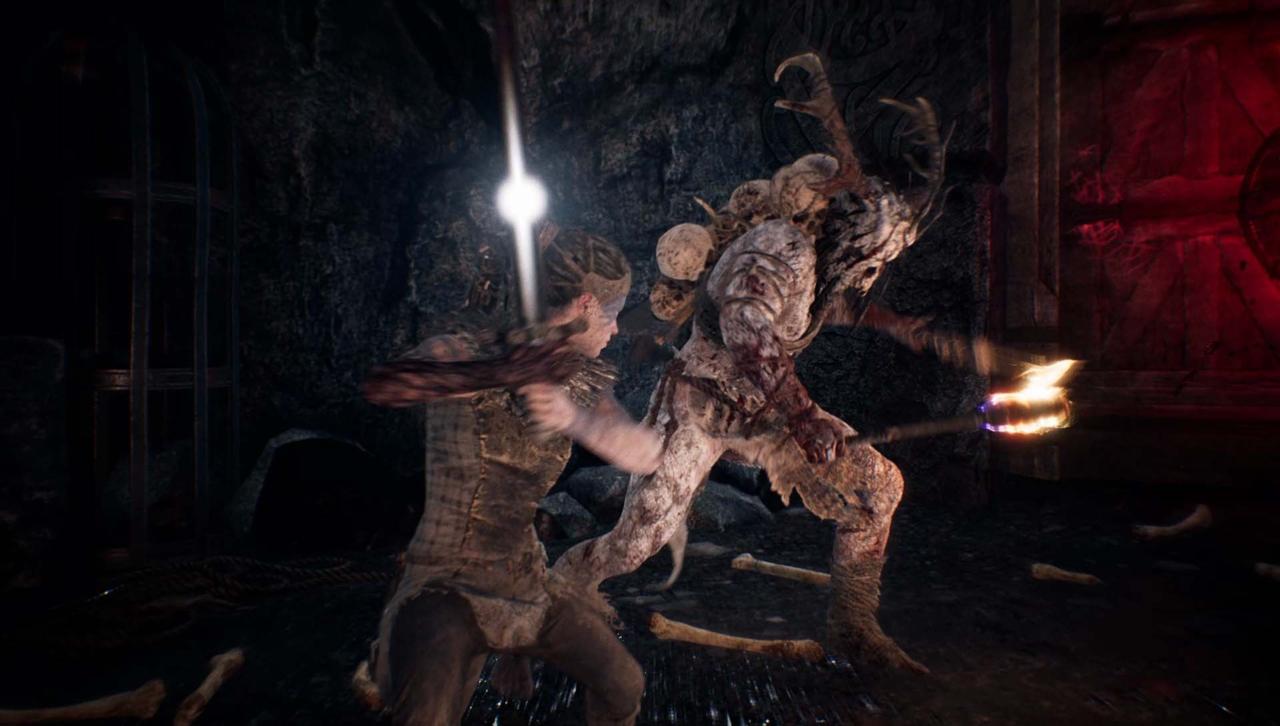In Hellblade: Senua’s Sacrifice, the struggle of coming to terms with past trauma and guilt comes out in a number of surprising ways. Developer Ninja Theory channels its talents for narrative and presentation to tell a personal story that has more to say than it initially lets on, and will likely leave you wondering what’s real, and what is a part of an elaborate hallucination.
In a far-off land covered in mist and fog, a traumatized celtic warrior named Senua embarks on a spiritual vision quest to suppress her inner demons, and come to grips with the death of her family. Plagued with severe psychosis, Senua’s past trauma manifests itself through duelling inner voices and visual hallucinations that compromise her emotional and mental state. On this journey, she’ll face abstract and reality-defying puzzles, and battle a seemingly endless horde of adversaries that aim to put a stop to her quest.
Pulling from Nordic and Celtic lore, the fiction of Hellblade evokes a dire and somewhat bleak atmosphere, making it seem like the world had already ended, leaving Senua with only the company of her memories. Hellblade is an introspective experience, albeit with several combat and interactive story beats scattered throughout. While the story and world are presented through cutscenes and stone glyphs depicting the history of the land, Hellblade also makes clever use of live-action cutscenes. These cinematic moments are blended into in-game graphics, giving each occurrence a somewhat surreal feeling, as if you’re watching a live playback of an altered memory.
On her journey through the cursed lands, Senua will come into conflict with the Northmen, an army of berserkers that appear out of thin air. These moments are when the combat comes into play, and it offers some of the most intense and thrilling moments of the game. Despite her illness weighing on her, Senua is still quite adept at fighting and is able to take on a number of foes at once. With fast, heavy sword swings, as well as up-close hand-to-hand strikes, you can use some light combos to hack away at the Northmen, while using dodges and parrying their strikes to get the upper hand.
Though combat is one of the core pillars in Hellblade, the game doesn’t concern itself with offering numerous weapons or complex skill-trees to work through. Aside from some new combat abilities unlocked at key story milestones, Senua’s arsenal of skills and weapons is kept light till the end. The true challenge and satisfaction comes from mastering the base combat mechanics, which is responsive, and fluid–allowing you to bounce between multiple foes easily, with her inner voices warning you of incoming strikes based on the position they’re coming from.











When it comes to portraying mental illness, Hellblade takes a sympathetic approach and isn’t at all interested in showing the differences between reality and imagination. It’s all about Senua’s perspective; with her visions and what’s truly real being presented as one in the same. One of the more oppressive aspects of her psychosis are the inner-voices, who quarrel with one another while commenting on the wandering warrior’s present state. Using binaural audio–which makes wearing headphones a must for the full effect–you’ll get to experience a taste of what it’s like to have several voices in your head.
In many ways, it feels like a subversive take on the common video game trope of the bodiless companion offering help via radio, making them a somewhat distressing presence you desperately wanted to keep at arm’s length. The effectiveness of the inner voices in making you uncomfortable is a testament to the stellar presentation of the game, which uses some rather inventive tricks to play with perspective and audio-sensory manipulation. It does well to make you feel on edge and in a state of confusion, while simultaneously getting you to focus on the more tangible and true elements of her surroundings–even if they are still hallucinations.
There are times where the voices become a boon to your survival–such as the rather tricky boss battles that force you change up your usual strategies–but the most useful instances come deeper in the game, when you’re able to clear through more than 20 foes consecutively, a far cry from the struggles of fighting only two to three foes. Many of these battles serve as the capper for narrative arcs in the story, making it feel like a cathartic emotional purge where you vanquish a construct of Senua’s past.
„It’s all about Senua’s perspective; with her visions and what’s truly real being presented as one in the same.“
While some characters from Senua’s past treated her mental state as a danger, she’s able to use it to her advantage to see the order in the chaos of her surroundings–finding patterns and solutions in ways that others wouldn’t have the presence of mind to see. Despite how terrifying and draining her psychosis can be, Senua is able navigate the various trials thanks to her unusually heightened perception, which comes out in a number of unique puzzle solving moments.
For the most part, puzzles revolve around unlocking doors by finding glyphs hidden in plain sight or in alternate perspectives that require manipulating Senua’s focus, illustrating her abstract attention to detail. While these puzzles can be clever, the same style occurs far too often, making some of the more drawn out sequences a chore. On the inverse, the moments where Senua is stripped of her senses and gear, forcing her to take a more subdued approach to avoid her enemies, felt far more engaging and interesting.
In one of the game’s best moments, the shadows themselves serve to be a real danger as Senua rushes from one light source to another in a dark cavern, all the while memories of her torment and anguish come flooding in–obscuring your vision while she’s making a dash to safety. These moments are a real highlight, channeling the same pulse-pounding sense of urgency found from set-piece moments in Resident Evil 4, making a seemingly simple objective into an unnerving experience–which in a way truly sums up what Hellblade is about. While these moments serve to be some of Hellblade’s most profound and affecting moments, it uses them sparingly to help break-up general puzzle solving and obstacles, which feel somewhat bland by comparison.











While Senua experiences many dangers, such as the horrific hallucinations of the dead, immolation by a mad fire god, and ravenous beasts that hide in the shadows–there is one threat that constantly looms over her that can result in dire consequences. Early on, Senua is infected with a corruption known as The Dark Rot, which continues to spread after she ‚dies‘ or fails a set-piece event. She passes failure and death off as another hallucination, but with every failure the infection spreads, and after multiple deaths it reaches her head. The result of this is Senua succumbing to her illness, forcing you to restart from the beginning of her journey.
Despite the inclusion of a permadeath mechanic, Hellblade is still a largely fair game. Taking around eight hours to clear on the hardest difficulty, and experiencing only a handful of deaths–mostly on account of some overly vague and awkward objectives coming off as obtuse, breaking the flow of traversal–the game is largely balanced with its pacing and difficulty. It even goes as far as to offer an auto-scaling difficulty system that adjusts based on how you’re playing. Interestingly, there’s no tutorial whatsoever in Hellblade, prompting you to learn the system by doing and listening to prompts from your inner voices.
Over the course of its journey, Hellblade keeps its gameplay lean in order to not overstay its welcome. Despite the complexity of the narrative and its presentation, combat only happens when it needs to, and puzzle solving and set-piece moments often drive the story forward to reveal more about Senua’s motivations. Which in turn reveals the struggles that torment her, preventing her from moving on.
Hellblade’s most notable achievement is the handling of an incredibly sensitive subject matter within an engaging and well-crafted action/adventure game. At its heart, the story is about Senua’s struggle to come to terms with her illness. In the process, she learns to find the strength within herself to endure, and to make peace with her past. And in a profound and physical way, we go through those same struggles with her, and come away with a better understanding of a piece of something that many people in the world struggle with.
Editor’s note: We have updated this review to reflect our time with the Xbox One version of Hellblade. We tested the game on an Xbox One X. — April 6, 2018
Website: LINK


